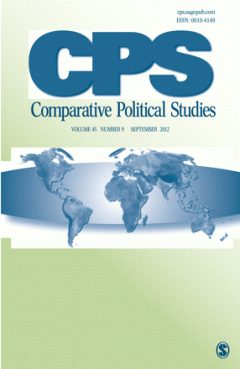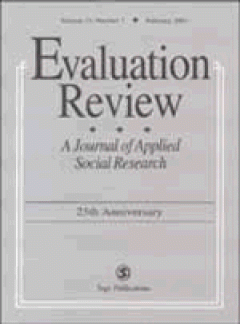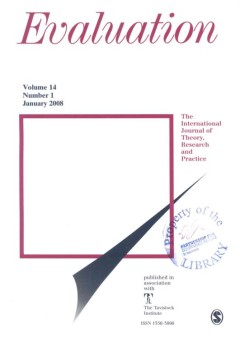Filter by

Modernization, Islam, or Social Capital: What Explains Attitudes Toward Democ…
This article explains the determinants of individual support for democracy in 10 Muslim-majority countries. Starting with economic and cultural interpretations of modernization theory, the author advances an argument exploring cross-linkages between macro- and micro-level implications of this theory as they relate to attitudes toward democracy. The author also provides a test of two alternative…
- Edition
- Vol. 43 no. 11, November 2010.pp. 1442-1470
- ISBN/ISSN
- 00104140
- Collation
- -
- Series Title
- Comparative Political Studies
- Call Number
- -

Does Crime Pay? Issue Ownership, Political Opportunity, and the Populist Righ…
This article contributes to the vast literature concerning extreme right parties in Western Europe by examining the effects of crime on the electoral success of these parties. Utilizing theories of issue ownership and political opportunity, this article argues that populist right parties appeal to voters who feel a sense of physical and social insecurity because of higher levels of crime. This …
- Edition
- Vol. 43 no. 11, November 2010.pp. 1471-1498
- ISBN/ISSN
- 00104140
- Collation
- -
- Series Title
- Comparative Political Studies
- Call Number
- -

Inequality and Democratization: A Contractarian Approach
Scholars continue to grapple with the question of the relationship between economic development and democratization; prominent recent research has focused on the effects of economic inequality. Boix suggests that democratization is likelier when inequality is low, whereas Acemoglu and Robinson argue that democratization is likelier when inequality is at middling levels. Both assume that democra…
- Edition
- Vol. 43 no. 12, December 2010.pp. 1543-1574
- ISBN/ISSN
- 00104140
- Collation
- -
- Series Title
- Comparative Political Studies
- Call Number
- -

Incentives for Personal Votes and Women’s Representation in Legislatures
To explain the gender gap in legislatures, scholars have identified several socio-economic, political, and cultural factors that undermine women�s representation. One explanation focuses on electoral institutions. Proportional representation systems with higher district magnitudes have been shown to increase the percentage of women in legislatures.The authors contend that solely concentrating o…
- Edition
- Vol. 43 no. 12, December 2010.pp. 1575-1600
- ISBN/ISSN
- 00104140
- Collation
- -
- Series Title
- Comparative Political Studies
- Call Number
- -

Perceptions of Electoral Fairness and Voter Turnout
Previous research has established a link between turnout and the extent to which voters are faced with a �meaningful� partisan choice in elections; this study extends the logic of this argument to perceptions of the �meaningfulness� of electoral conduct. It hypothesizes that perceptions of electoral integrity are positively related to turnout. The empirical analysis to test this hypothesis is b…
- Edition
- Vol. 43 no. 12, December 2010.pp. 1601-1622
- ISBN/ISSN
- 00104140
- Collation
- -
- Series Title
- Comparative Political Studies
- Call Number
- -

Cities on Fire: Social Mobilization, State Policy, and Urban Insurgency
Major theories of civil war emphasize the social and military attributes of rural terrain as key causes of conflict. This focus has led scholars to ignore important urban insurgencies in the Middle East and South Asia. This article makes two arguments about the roots of urban insurgency. First, it shows that robust urban social mobilization is possible and common. This can provide a social base…
- Edition
- Vol. 43 no. 12, December 2010. pp. 1623-1649
- ISBN/ISSN
- 00104140
- Collation
- -
- Series Title
- Comparative Political Studies
- Call Number
- -

Citizens’ Perceptions of Government Responsiveness in Africa: Do Electoral …
How do electoral systems influence citizens� perceptions of government responsiveness? It is well known that although majoritarian electoral systems emphasize the directness and clarity of the connection between voters and policy makers, proportional representation systems facilitate the representation of all factions in society. Although there have been a few studies of the direct influence of…
- Edition
- Vol. 43 no. 12, December 2010. pp. 1650-1674
- ISBN/ISSN
- 00104140
- Collation
- -
- Series Title
- Comparative Political Studies
- Call Number
- -

Gathering Time-Series Data for Evaluating Behavior-Change Campaigns in Develo…
Gathering time-series data of behaviors and psychological variables is important to understand, guide, and evaluate behavior-change campaigns and other change processes. However, repeated measurement can affect the phenomena investigated, particularly frequent face-to-face interviews, which are often the only option in developing countries. This article presents three intervention control studi…
- Edition
- Vol. 34 no. 5, October 2010.pp. 367-390
- ISBN/ISSN
- 0193841x
- Collation
- -
- Series Title
- Evaluation Review
- Call Number
- -

Improving the Use of Self-Generated Identification Codes
In panel studies on sensitive topics, respondent-generated identification codes are often used to link records across surveys. However, usually a substantial number of cases are lost due to the codes. These losses may cause biased estimates. Using more components and linking the codes by the Levenshtein string distance function will reduce the losses. In a simulation study and two field experim…
- Edition
- Vol. 34 no. 5, October 2010.pp. 391-418
- ISBN/ISSN
- 0193841x
- Collation
- -
- Series Title
- Evaluation Review
- Call Number
- -

A Learner-Focused Evaluation Strategy: Developing Medical Education through a…
This article describes and discusses a case of deliberative responsive stakeholder evaluation that was employed as a strategy to support the development of an undergraduate medical programme at a Swedish university. It focuses on received information and reflection about the process of evaluation as a dialogue for learning. By highlighting the complexity of educational work and the ex…
- Edition
- Vol. 14, No. 1, January 2008. Page 91-106
- ISBN/ISSN
- 1356-3890
- Collation
- -
- Series Title
- Evaluation
- Call Number
- -

Realistic Evaluation of an Illicit Drug Deterrence Programme: Analysis of a C…
This article describes an evaluation conducted in a region of northern Italy, based on the realistic evaluation approach.This case study is related to the application at regional level of national legislative measures against personal drug consumption, the so-called Article 75, through the implementation of a pilot programme. Article 75 DPR 309/90, is a `sanctions-based' intervention main…
- Edition
- Vol. 14, No. 1, January 2008. Page 9-28
- ISBN/ISSN
- 13563890
- Collation
- -
- Series Title
- Evaluation
- Call Number
- -

Using Programme Theory to Evaluate Complicated and Complex Aspects of Interve…
This article proposes ways to use programme theory for evaluating aspects of programmes that are complicated or complex. It argues that there are useful distinctions to be drawn between aspects that are complicated and those that are complex, and provides examples of programme theory evaluations that have usefully represented and address both of these. While complexity has been defined in…
- Edition
- Vol. 14, No.1, Page 29-48
- ISBN/ISSN
- 1356-3890
- Collation
- -
- Series Title
- Evaluation
- Call Number
- -

A Methodology for a Structured Survey of the Healthcare Literature related to…
This article reports on the structured literature survey methodology, which was used to identify how and at what stage users of medical devices are engaged in the medical device technology cycle, including methods and tools for evaluating device outcomes.This was not a conventional systematic review of the literature. The stated purpose of the survey is broader than synthesizing best evi…
- Edition
- Vol. 14, No. 1, January 2008. Page 49-73
- ISBN/ISSN
- 1356-3890
- Collation
- -
- Series Title
- Evaluation
- Call Number
- -

Evaluating Complex, Area-Based Initiatives in a Context of Change: The Experi…
Complex, area-based initiatives are a widely adopted policy response to problems of health inequalities and social exclusion in industrialized countries such as the UK and the US.This article explores the problems of evaluating such initiatives in a context of rapid national and local policy change by drawing on the Children's Fund, a UK government initiative that established local partne…
- Edition
- Vol. 14, No. 1, January 2008. Page 75-90
- ISBN/ISSN
- 1356-3890
- Collation
- -
- Series Title
- Evaluation
- Call Number
- -

Balancing Independence and Responsiveness: A Practitioner Perspective on the …
This article examines the relationships of the National Audit Office (NAO) — the state audit institution (SAI) of the United Kingdom — with a range of third parties that shape the performance audit work the NAO undertakes. In particular, it considers from a practitioner perspective how the NAO has sought to balance its independence with the desire to be responsive to the expectations of o…
- Edition
- Vol. 14, No. 2, March 2008. Page 227-248
- ISBN/ISSN
- 1356-3890
- Collation
- -
- Series Title
- Evaluation
- Call Number
- -

The European Project, Federalism and Evaluation
The US federalist system has been at the origin of evaluation in many ways: providing a laboratory for experimentation of innovative policies, and requiring evaluation of the growing federal intervention from the War on Poverty onwards. Evaluation approaches have been developed that took into consideration the multiple forms of collaboration activated by the federalist system.This experienc…
- Edition
- Vol. 14, No. 2, April 2008. Page 117-140
- ISBN/ISSN
- 1356-3890
- Collation
- -
- Series Title
- Evaluation
- Call Number
- -

Improving Performance?: Exploring the Complementarities between Evaluation an…
This article focuses on what some sceptics see as disillusionment with conventional evaluation practice, in that many governments experience only limited use of evaluation findings.This has contributed to a significant increase in results-based performance measurement. Yet not everyone in the evaluation community welcomes this development.The authors make the point that significant compleme…
- Edition
- Vol. 14, No. 2, April 2008. Page 171-192
- ISBN/ISSN
- 1356-3890
- Collation
- -
- Series Title
- Evaluation
- Call Number
- -

Evaluation of Change in Local Governance: The Rhetorical Wall and the Politic…
This article, grounded in evaluation research on intermunicipal cooperation, contends that processes of change in local government present specific challenges for evaluation. In the course of data collection, researchers encountered a phenomenon that they called `the rhetorical wall', where there is a wide gap between intentions as expressed at the rhetorical level and what actually occurs.T…
- Edition
- Vol. 14, No. 2, April 2008. Page 141-155
- ISBN/ISSN
- 13563890
- Collation
- -
- Series Title
- Evaluation
- Call Number
- -

Current Challenges in Development Evaluation
Over the past 20 years, the development industry has changed rapidly and now presents evaluators with a series of new challenges.This article considers this process of change. It argues that there has been a move away from a `project-based' approach to a broader vision of development centred on the Millennium Development Goals, which has led to a change of the evaluation approach: from an ass…
- Edition
- Vol. 14, No. 2, April 2008. Page 193-208
- ISBN/ISSN
- 13563890
- Collation
- -
- Series Title
- Evaluation
- Call Number
- -

Evaluation Systems: What Are They and Why Study Them?
Increasingly, in the world of evaluation, `systems of evaluation' have been developed.This article outlines four criteria that help characterize such systems. One criterion is the existence of a distinctive epistemological perspective; another is that, in order to be labelled a system, evaluation activities are carried out by evaluators within organizational structures and institutions and n…
- Edition
- Vol. 14, No. 2, April 2008. Page 157-169
- ISBN/ISSN
- 1356-3890
- Collation
- -
- Series Title
- Evaluation
- Call Number
- -
 Computer Science, Information & General Works
Computer Science, Information & General Works  Philosophy & Psychology
Philosophy & Psychology  Religion
Religion  Social Sciences
Social Sciences  Language
Language  Pure Science
Pure Science  Applied Sciences
Applied Sciences  Art & Recreation
Art & Recreation  Literature
Literature  History & Geography
History & Geography